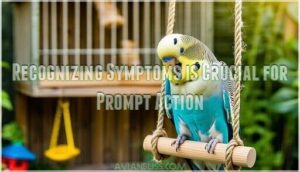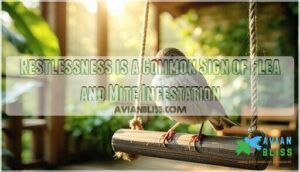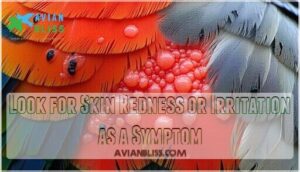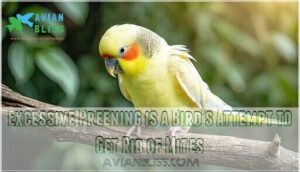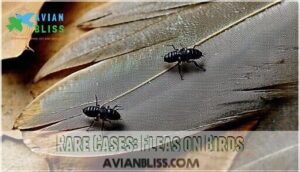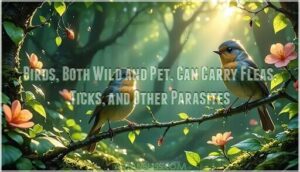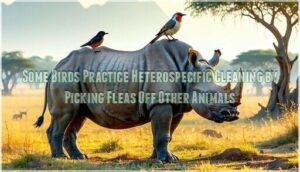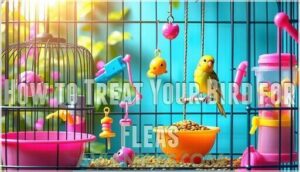This site is supported by our readers. We may earn a commission, at no cost to you, if you purchase through links.
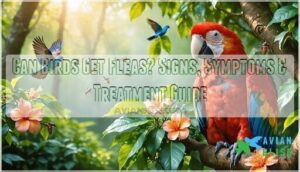
Most scratching and irritation you’ll see in pet birds comes from mites or lice, not fleas.
However, certain hook-billed birds like parrots can occasionally pick up fleas if they’re exposed to infested environments or other flea-carrying animals.
Wild birds might encounter fleas in their nests or when interacting with mammals.
If you notice your bird scratching excessively, showing skin irritation, or preening more than usual, don’t assume it’s fleas, as these symptoms more likely indicate mites or lice, which require different treatment approaches than traditional flea control methods.
Table Of Contents
- Key Takeaways
- Birds and Fleas: Uncommon but Possible
- Fleas and Mites in Pet Birds
- Rare Cases: Fleas on Birds
- Birds as Flea Carriers
- How to Treat Your Bird for Fleas
- Flea Treatments for Pet Birds Should Be Recommended by a Vet Due to Sensitivity to Chemicals
- Treating The Bird’s Cage and Toys is Essential to Eliminate Fleas and Eggs
- Diatomaceous Earth Can Be Used in Aviaries to Kill Adult Fleas Without Harming Birds
- Bird Fleas Are Small and Brown and Can Jump From Birds to Humans but Don’t Usually Live on Humans
- Professional Help May Be Needed to Deal With a Flea Problem in The Yard
- Frequently Asked Questions (FAQs)
- Can birds have fleas?
- Can birds get fleas and ticks?
- Can birds get fleas from cats?
- Can fleas cause health problems in birds?
- What happens if a bird ingests fleas?
- Do fleas bite birds?
- What do bird fleas look like?
- Can bird fleas live on humans?
- Can fleas live in beds?
- How do you know if your bird has fleas?
- Conclusion
Key Takeaways
- You’ll rarely see fleas on birds – Most scratching and irritation come from mites or lice, not fleas, since birds’ feather structure and body temperature make them unattractive hosts
- Hook-billed birds like parrots can occasionally get fleas – This happens when they are exposed to infested environments or contact with flea-carrying animals, though it’s still uncommon
- Don’t assume it’s fleas if your bird’s scratching – Excessive preening, skin irritation, and restlessness more likely indicate mites or lice, which require different treatment approaches
- Always consult your vet before treating parasites – Birds are extremely sensitive to chemicals, and most flea treatments safe for cats and dogs can be toxic or deadly to your feathered friend
Birds and Fleas: Uncommon but Possible
While birds don’t commonly get fleas like cats and dogs do, it’s not impossible under certain circumstances.
You might notice your feathered friend scratching more than usual, which could indicate parasites like mites, lice, or in rare cases, fleas.
Bird Scratching May Be Due to Parasites Like Mites or Lice
When your bird’s constantly scratching, it’s likely dealing with bird mites or bird lice rather than fleas.
These tiny bird parasites cause significant skin irritation and feather loss through their feeding habits. Watch for excessive preening, restlessness, and visible irritation around feather bases.
Bird mites are particularly common and can quickly spread throughout your flock. Effective parasite control starts with regular cage cleaning and quarantining new birds.
Unlike flea bites, mite infestations create clusters of small red spots on exposed skin. A veterinary examination can distinguish between different bird parasites and recommend appropriate treatment before the bird scratching becomes a serious bird infestation.
Some Hook-bill Birds Like Parrots Can Get Fleas
While hookbill birds like parrots don’t commonly get fleas, they’re not immune to these pesky parasites.
Your feathered friend can pick up parrot fleas in crowded aviaries or through contact with infested animals.
Once established, bird fleas spread quickly through close quarters, making flea prevention vital for maintaining excellent avian health.
You’ll notice your parrot preening constantly, desperately trying to remove these irritating insects from their feathers.
This excessive grooming behavior often signals a flea infestation that needs immediate attention.
Here’s what makes parrot fleas particularly concerning:
- Rapid spread – Fleas jump between birds housed together, creating widespread bird infestations
- Persistent irritation – Your parrot can’t escape the constant itching and discomfort
- Treatment challenges – Anti-flea sprays often irritate delicate bird skin, complicating treatment
- Health risks – Untreated bird parasites can lead to serious complications including feather mites
Before attempting any flea treatment, consult an avian veterinarian who understands pet bird health.
They’ll recommend safe, effective solutions that won’t harm your parrot’s sensitive system.
Bird Fleas Can Occur if Birds Are Exposed to Infested Areas
Exposure to contaminated environments puts your feathered friends at risk for flea infestation.
Bird fleas thrive in areas where infected mammals have been, including yards, parks, and outdoor aviaries.
Different flea species can jump onto birds when they forage or nest in these spaces.
Your bird’s health depends on avoiding infested locations.
Implement flea prevention by checking outdoor areas before allowing access.
Bird parasite control starts with understanding nesting habits and monitoring for early signs of bird health issues.
Be Cautious When Letting Birds Outside in Flea-prone Areas
Taking your feathered friend outdoors requires smart planning when fleas lurk nearby. These tiny jumpers don’t discriminate between furry and feathered hosts, making bird protection your top priority.
- Scout the territory first – Check grass height, moisture levels, and recent animal activity before release
- Create a safe bubble – Use portable enclosures or supervised flight areas away from ground cover
- Time it right – Early morning visits reduce flea activity when dew dampens their jumping ability
- Pack your exit strategy – Keep carriers ready for quick retreats if you spot flea dirt or excessive scratching
Flea transmission happens faster than you’d expect. Bird fleas thrive in warm, humid conditions where wild animals frequent.
Your bird’s outdoor adventure shouldn’t become a flea infestation nightmare. Smart flea prevention starts with recognizing outdoor risks before they become bird health issues requiring intensive bird parasite control measures.
Proper bird health sanitation practices, including daily cage cleaning, are essential in preventing the spread of diseases and parasites.
Check for Fleas if You or Your Pets Have Flea Bites
If you or your pets have flea bites, immediately inspect your birds for fleas too.
Flea inspection should focus on areas under wings, legs, and bellies where bird parasites hide.
Use bright lighting and a magnifying glass to spot these tiny brown insects in feathers.
Bird flea symptoms include excessive scratching and small black specks (flea dirt).
When you discover a flea infestation, quarantine affected birds, clean cages thoroughly, and treat all pets simultaneously for effective flea control and prevention.
Fleas and Mites in Pet Birds
Pet birds can develop flea and mite infestations that cause significant discomfort and health problems.
Tiny parasites can turn your feathered friend’s comfortable home into an itchy nightmare requiring immediate attention.
These tiny parasites feed on your bird’s blood and can quickly multiply if left untreated, making early detection essential for your pet’s wellbeing.
Fleas and Mites Can Infect Pet Birds, Causing Discomfort
Pet birds face discomfort when fleas and mites invade their space.
These tiny parasites feed on your bird’s blood, causing skin irritation and behavioral changes.
Bird mites are more common than bird fleas, but both create similar problems for your feathered companion.
- Flea Biology: Adult fleas jump onto birds to feed while laying eggs that fall into cage bedding
- Bird Health: Blood-feeding parasites weaken immune systems and cause anemia in severe cases
- Parasite Control: Regular avian hygiene prevents flea infestation from spreading throughout your home
Professional bird health monitoring helps detect early signs before parasites multiply rapidly in warm environments.
Effective bird flea spray products are essential for preventing the spread of these parasites.
Recognizing Symptoms is Crucial for Prompt Action
Early flea detection saves your bird from unnecessary suffering and prevents minor issues from becoming serious health problems.
Watch for increased scratching, feather plucking, or skin irritation around your bird’s head and neck areas. Flea bites create red, inflamed spots that birds constantly peck at, leading to feather loss and potential skin infections.
Black specks in your bird’s cage or on perches indicate flea dirt – a telltale sign of flea infestation.
Bird health deteriorates quickly when fleas multiply, so don’t wait if you notice these flea symptoms. Health risks increase dramatically without prompt intervention.
Effective bird flea medicine requires understanding of flea control methods to prevent re-infestation.
Restlessness is a Common Sign of Flea and Mite Infestation
When dealing with bird fleas and bird mites, you’ll notice your feathered friend can’t seem to settle down.
Bird restlessness often signals these tiny parasites are causing serious discomfort.
Flea infestation creates constant itch symptoms that keep birds moving even during normal rest periods.
This bird stress manifests as continuous shifting, frequent position changes, and inability to relax.
- Monitor for excessive movement during typical resting hours
- Watch for repetitive scratching or preening behaviors throughout the day
- Check if your bird seems unable to get comfortable in familiar perches
Nest infestation compounds the problem, as flea bites create ongoing irritation that disrupts normal sleep patterns and daily routines.
Understanding the mite infestation signs is essential for effective treatment and prevention of further complications.
Look for Skin Redness or Irritation as a Symptom
When examining your bird, watch for telltale signs of skin irritation that signal flea or mite problems.
Red, irritated skin around your bird’s head and neck often signals active flea feeding.
Red, inflamed patches around the head, neck, and vent area often indicate active parasites.
Bird flea bites create small, raised bumps that appear pinkish or red against your pet’s normal skin tone.
You’ll notice skin irritation develops gradually as parasites feed and multiply.
Bird skin becomes tender and raw from constant scratching, creating open wounds that can lead to secondary infections.
Flea bites typically cluster in areas where feathers are thinner, making detection easier during regular health checks.
Bird flea skin irritation differs from other conditions because it’s accompanied by visible parasites or their waste products.
Look for tiny black specks near irritated areas – these are flea droppings that confirm an active infestation.
Redness symptoms worsen without treatment, spreading to larger skin areas.
Effective bird flea treatment often involves using flea medication products.
Prompt veterinary attention prevents complications when you spot these warning signs on your feathered companion.
Excessive Preening is a Bird’s Attempt to Get Rid of Mites
When your bird can’t stop grooming itself, it’s likely fighting mites or bird fleas.
This excessive preening behavior signals mite infestation and requires immediate attention for proper bird hygiene.
Watch for these key signs of problematic preening behavior:
- Constant scratching – Your bird repeatedly claws at the same spots
- Feather damage – Broken or missing plumage from over-grooming
- Skin irritation – Red, inflamed areas where they’ve been picking
- Restless movement – Unable to settle due to discomfort
- Focused attention – Targeting specific body parts repeatedly
This intensive bird grooming differs from normal feather care.
Healthy birds preen regularly but don’t obsess over particular areas.
Bird mite removal becomes necessary when preening turns destructive, causing bald patches or wounds.
Rare Cases: Fleas on Birds
While fleas on birds are extremely uncommon due to their feather structure and body temperature, certain species of bird fleas do exist and can infest nests during breeding season.
You’re more likely to encounter these parasites if your bird has been exposed to infested environments or other animals carrying fleas.
Fleas on Birds Are Highly Unlikely
Fleas rarely choose birds as hosts due to flea biology and bird behavior differences.
Birds maintain higher body temperatures that make them less attractive to these parasites. Their feathers create barriers that complicate flea transmission compared to mammalian fur.
Most bird fleas are species-specific, preferring wild bird nests over pet birds.
Regular bird hygiene through preening and dust baths naturally prevents flea infestations. While flea problems can occur, proper avian health care and parasite control make bird pest control manageable for most pet owners.
Birds May Have Bird Fleas in Their Nests
Nesting sites often harbor unexpected visitors that can affect bird health.
Bird fleas thrive in nest environments, completing their flea lifecycle in organic debris and emerging when birds return.
- Remove old nesting material and replace it regularly to disrupt nest parasites
- Apply diatomaceous earth around aviaries for safe bird pest control without chemicals
- Monitor for flea infestation signs like excessive preening or skin irritation in birds
Avian fleas jump from contaminated bird nests onto hosts, making thorough nest cleaning essential for preventing flea infestations and maintaining ideal bird health.
Rabbits Can Get Fleas, So Monitor Them
While rabbits aren’t birds, they can carry flea species that potentially affect your feathered friends.
Monitor your rabbit’s fur weekly for tiny jumping insects or black specks indicating flea infestations. Regular pet monitoring helps with flea prevention and flea control.
Check bedding areas where fleas reproduce. If you spot signs, consult your vet for safe flea treatment options that won’t harm your rabbit’s health or nearby bird care routines.
Avoid Using Flea Shampoo on Pets, as Fleas Can Hide
Most pet owners assume flea shampoo provides complete protection, but these cunning parasites have mastered the art of survival.
When you bathe your dog or cat, fleas don’t simply wash away—they retreat deeper into your pet’s fur, holding their breath and waiting out the storm.
Here’s why flea shampoo alone falls short for effective flea treatment:
- Flea Hiding Tactics: Hidden fleas burrow into dense fur areas where shampoo can’t penetrate effectively
- Survival Instincts: These pests can hold their breath for extended periods during bathing
- Quick Recovery: Once your pet dries, surviving fleas resume their blood-feeding activities
For thorough pet safety and flea infestations control, combine shampooing with environmental treatments targeting carpets, bedding, and yard areas where flea eggs develop.
Borax Can Be Used for Flea Control in The Home
Sprinkling borax around your home creates an effective barrier against flea infestations.
This natural flea control method works by dehydrating adult fleas and disrupting their life cycle.
Apply borax powder to carpets, cracks, and baseboards where fleas hide.
Vacuum thoroughly after 24 hours to remove dead fleas and borax residue for safe flea management.
Birds as Flea Carriers
Both wild and pet birds can carry fleas, ticks, and other external parasites that may affect their health and behavior.
You might be surprised to learn that some bird species even help other animals by picking fleas off them in a behavior called heterospecific cleaning.
Birds, Both Wild and Pet, Can Carry Fleas, Ticks, and Other Parasites
Both wild and pet birds can transport parasites across different environments.
Your feathered companion may pick up fleas, ticks, or mites during outdoor exposure or contact with infected animals.
Bird fleas are species-specific but can occasionally affect other animals.
Common parasite carriers include:
- Wild birds – Transport fleas and ticks during migration
- Pet birds – Acquire parasites from outdoor exposure or infected pets
- Nesting birds – Harbor flea eggs that continue infestation cycles
- Migratory species – Spread parasites across wide geographical areas
Effective parasite control requires monitoring your bird’s behavior for excessive scratching or preening.
Flea prevention starts with proper avian hygiene and regular health checks.
Understanding tick life cycles is essential for managing parasite-borne diseases in birds.
Some Birds Practice Heterospecific Cleaning by Picking Fleas Off Other Animals
You’ve seen birds perched on cattle or rhinos, picking through their fur.
This behavior, called heterospecific cleaning, helps both species survive.
Birds get nutritious meals from fleas and ticks, while large mammals receive flea removal services.
Oxpeckers excel at this cleaning practice, targeting bird fleas and other avian pests on their hosts.
This animal interaction reduces flea transmission between species and demonstrates how bird behavior adapts for mutual benefit.
Understanding these cleaning practices helps explain flea infestation patterns and supports effective bird health management strategies, which is crucial for overall ecosystem balance.
Birds in The Wild Use Various Methods to Deal With Fleas
Wild birds have developed smart ways to handle bird fleas and other parasites.
They’ll dust-bathe in dirt or sand, which helps remove these tiny pests from their feathers.
Many species also practice anting, where they rub ants on their plumage – the formic acid acts as a natural insecticide.
Some birds use smoke from fires or strong-smelling plants for feather protection against wild infestations.
Pet Birds, Like Parrots, Can Also Get Fleas, Which Can Spread Easily
Pet birds like parrots can contract fleas from outdoor exposure or contact with flea infested birds. These parasites spread quickly through aviaries, creating health risks for your feathered companions.
Parakeets and other pet birds show infestation signs including excessive scratching and feather damage.
To prevent flea infestations, follow these steps:
- Quarantine new birds before introducing them to existing flocks
- Monitor for flea species that commonly affect bird health
- Implement flea prevention measures recommended by avian veterinarians
Early detection of treatment options helps prevent widespread infestations in your bird collection.
How to Treat Your Bird for Fleas
If your bird has fleas, you’ll need veterinary guidance since birds are extremely sensitive to most flea treatments that work on mammals.
Start by thoroughly cleaning and treating your bird’s cage, perches, and toys to eliminate flea eggs and larvae that could reinfest your pet.
Flea Treatments for Pet Birds Should Be Recommended by a Vet Due to Sensitivity to Chemicals
Before treating your bird for fleas, you’ll need vet guidance due to birds’ extreme chemical sensitivity.
Many flea medications safe for cats and dogs can cause respiratory distress or death in pet birds.
Your veterinarian will recommend bird-safe treatments like controlled ivermectin doses or natural alternatives.
| Treatment Type | Safety Level | Vet Required | Notes |
|---|---|---|---|
| Mammal flea sprays | Dangerous | Yes | Toxic to birds |
| Ivermectin | Safe | Yes | Strict dosage control |
| Natural remedies | Variable | Yes | Professional guidance needed |
| Topical treatments | Risky | Yes | Respiratory concerns |
Professional bird care tips guarantee safe treatment without compromising bird health through proper flea chemicals selection.
Treating The Bird’s Cage and Toys is Essential to Eliminate Fleas and Eggs
Beyond treating your bird, you’ll need thorough cage cleaning and toy sanitizing to break the flea lifecycle.
Flea eggs hide in every corner, making complete nest disinfection essential for effective bird hygiene.
- Remove and wash all perches, toys, and accessories with hot soapy water
- Vacuum cage corners and crevices where flea eggs accumulate
- Disinfect the entire bird cage with bird-safe cleaning solutions
- Replace bedding materials completely during flea removal process to ensure complete nest disinfection
Diatomaceous Earth Can Be Used in Aviaries to Kill Adult Fleas Without Harming Birds
Diatomaceous earth provides effective flea control for aviaries without endangering your birds.
This natural powder works by physically damaging flea exoskeletons, causing dehydration and death.
Apply DE as a thin layer on aviary floors, perches, and nesting areas—never directly on birds.
The microscopic fossils scratch adult fleas while remaining completely safe for bird health.
Reapply after cleaning or rainfall to maintain effectiveness.
Always wear a mask during application and make certain birds have powder-free areas to prevent respiratory irritation.
Bird Fleas Are Small and Brown and Can Jump From Birds to Humans but Don’t Usually Live on Humans
Through close contact with infested birds, these tiny brown parasites can temporarily jump onto human skin but won’t establish permanent residence there.
- Flea Transmission occurs mainly through direct bird handling or cage cleaning activities
- Bird Infestation spreads when adult fleas leap between hosts seeking blood meals
- Flea Biology shows these parasites prefer feathered hosts over human skin for reproduction
- Human Exposure typically results in temporary bites rather than lasting colonization
- Flea Control requires treating both the bird and its environment simultaneously
Bird fleas measure about 5/16 inches and appear as small, dark specks moving quickly through feathers.
While bird flea reproduction happens primarily in nests and cages, adult fleas may bite humans during bird flea treatment procedures.
This bird flea nuisance creates temporary discomfort but rarely leads to sustained human infestations since these parasites can’t complete their lifecycle on people.
People handling birds should be aware of mite infestation risks to take proper precautions and prevent potential health issues.
Professional Help May Be Needed to Deal With a Flea Problem in The Yard
When yard flea problems persist despite treatment efforts, professional pest management becomes necessary.
Exterminators can assess the severity of your flea infestation and apply specialized treatments that target both adult fleas and developing larvae in outdoor environments.
| Service Type | Treatment Method | Timeline |
|---|---|---|
| Initial Assessment | Property inspection and flea population mapping | 1-2 hours |
| Chemical Treatment | Professional-grade insecticides for lawn care | 2-4 weeks |
| Follow-up Monitoring | Re-evaluation and additional flea removal if needed | 30-60 days |
Professional flea control services understand the lifecycle patterns of bird fleas and can recommend ongoing yard treatment strategies to prevent future infestations that might affect your feathered friends.
Frequently Asked Questions (FAQs)
Can birds have fleas?
Like feathered friends facing unwelcome guests, birds can indeed get fleas.
These tiny parasites jump onto birds to feed on their blood, causing irritation, feather damage, and potential health issues in both wild and pet birds, which can lead to significant irritation.
Can birds get fleas and ticks?
Yes, birds can get both fleas and ticks.
Bird fleas specifically target avian hosts, while ticks also attach to birds for blood meals.
You’ll notice increased scratching, feather damage, and small dark specks on your bird’s skin indicating these parasites.
Can birds get fleas from cats?
Birds can catch fleas from cats through direct contact or by visiting areas where infected cats have been.
Cat fleas aren’t picky about hosts and will happily jump onto birds for a blood meal.
Can fleas cause health problems in birds?
Fleas definitely cause serious health problems in birds.
You’ll notice excessive scratching, feather loss, and skin irritation from flea bites.
Heavy infestations can lead to anemia, especially dangerous for young birds who may die from blood loss, which is a serious health issue caused by flea bites.
What happens if a bird ingests fleas?
If your bird accidentally ingests fleas while preening, it’s typically harmless since fleas aren’t toxic. The bird’s digestive system will process them naturally without causing health issues or complications.
Do fleas bite birds?
Like a magnet to metal, fleas definitely bite birds to feed on their blood.
You’ll find these tiny parasites causing skin irritation, feather damage, and potentially serious health issues in your feathered friends.
What do bird fleas look like?
These tiny brown parasites measure up to 5/16 inches long, with visible eyes, antennae, and piercing mouthparts designed for blood feeding.
You’ll spot their wingless bodies and characteristically long hind legs built for jumping.
Can bird fleas live on humans?
Bird fleas typically can’t establish permanent populations on humans.
While they might occasionally bite you, they prefer avian hosts and won’t survive long-term on human skin due to our different body temperature and lack of feathers, making human skin an unfavorable environment for their permanent residence.
Can fleas live in beds?
Yes, fleas can definitely live in your bed.
They’ll hide in mattresses, bedding, and carpets near sleeping areas, feeding on you at night and laying eggs that hatch into more fleas.
How do you know if your bird has fleas?
You’ll notice excessive scratching, feather loss, and small black specks (flea dirt) on your bird’s feathers or skin.
Look for skin irritation, redness around the vent area, and increased preening behavior indicating discomfort, which can also include feather loss.
Conclusion
While your feathered friend might look like they’re auditioning for a flea circus, the truth is can birds get fleas remains an uncommon occurrence.
Most bird scratching stems from mites or lice, not fleas. However, hook-billed birds like parrots can occasionally pick up these unwelcome hitchhikers from infested environments.
Watch for excessive preening, skin irritation, or restlessness as warning signs. Always consult your veterinarian before treating suspected parasites, as birds require specialized care approaches different from traditional flea treatments.


